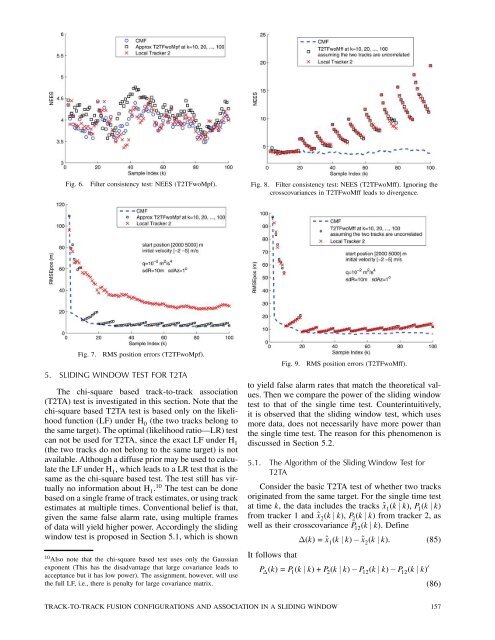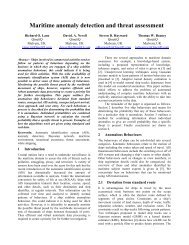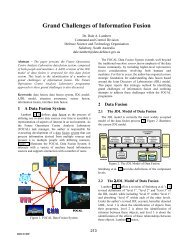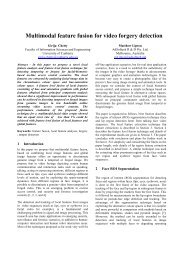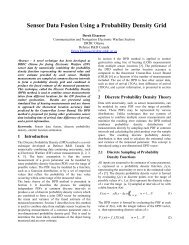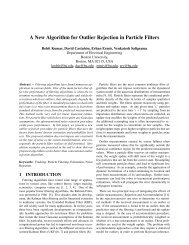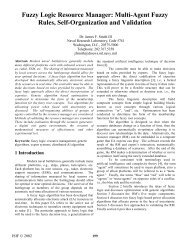Track-to-Track Fusion Configurations and Association in a ... - ISIF
Track-to-Track Fusion Configurations and Association in a ... - ISIF
Track-to-Track Fusion Configurations and Association in a ... - ISIF
You also want an ePaper? Increase the reach of your titles
YUMPU automatically turns print PDFs into web optimized ePapers that Google loves.
Fig. 6.<br />
Filter consistency test: NEES (T2TFwoMpf).<br />
Fig. 8. Filter consistency test: NEES (T2TFwoMff). Ignor<strong>in</strong>g the<br />
crosscovariances <strong>in</strong> T2TFwoMff leads <strong>to</strong> divergence.<br />
Fig. 7.<br />
RMS position errors (T2TFwoMpf).<br />
5. SLIDING WINDOW TEST FOR T2TA<br />
The chi-square based track-<strong>to</strong>-track association<br />
(T2TA) test is <strong>in</strong>vestigated <strong>in</strong> this section. Note that the<br />
chi-square based T2TA test is based only on the likelihood<br />
function (LF) under H 0 (the two tracks belong <strong>to</strong><br />
the same target). The optimal (likelihood ratio–LR) test<br />
can not be used for T2TA, s<strong>in</strong>ce the exact LF under H 1<br />
(the two tracks do not belong <strong>to</strong> the same target) is not<br />
available. Although a diffuse prior may be used <strong>to</strong> calculate<br />
the LF under H 1 , which leads <strong>to</strong> a LR test that is the<br />
same as the chi-square based test. The test still has virtually<br />
no <strong>in</strong>formation about H 1 . 10 The test can be done<br />
based on a s<strong>in</strong>gle frame of track estimates, or us<strong>in</strong>g track<br />
estimates at multiple times. Conventional belief is that,<br />
given the same false alarm rate, us<strong>in</strong>g multiple frames<br />
of data will yield higher power. Accord<strong>in</strong>gly the slid<strong>in</strong>g<br />
w<strong>in</strong>dow test is proposed <strong>in</strong> Section 5.1, which is shown<br />
10 Also note that the chi-square based test uses only the Gaussian<br />
exponent (This has the disadvantage that large covariance leads <strong>to</strong><br />
acceptance but it has low power). The assignment, however, will use<br />
the full LF, i.e., there is penalty for large covariance matrix.<br />
Fig. 9.<br />
RMS position errors (T2TFwoMff).<br />
<strong>to</strong> yield false alarm rates that match the theoretical values.<br />
Then we compare the power of the slid<strong>in</strong>g w<strong>in</strong>dow<br />
test <strong>to</strong> that of the s<strong>in</strong>gle time test. Counter<strong>in</strong>tuitively,<br />
it is observed that the slid<strong>in</strong>g w<strong>in</strong>dow test, which uses<br />
more data, does not necessarily have more power than<br />
the s<strong>in</strong>gle time test. The reason for this phenomenon is<br />
discussed <strong>in</strong> Section 5.2.<br />
5.1. The Algorithm of the Slid<strong>in</strong>g W<strong>in</strong>dow Test for<br />
T2TA<br />
Consider the basic T2TA test of whether two tracks<br />
orig<strong>in</strong>ated from the same target. For the s<strong>in</strong>gle time test<br />
at time k, the data <strong>in</strong>cludes the tracks ˆx 1 (k j k), P 1 (k j k)<br />
from tracker 1 <strong>and</strong> ˆx 2 (k j k), P 2 (k j k) from tracker 2, as<br />
well as their crosscovariance P 12 (k j k). Def<strong>in</strong>e<br />
¢(k)=ˆx 1 (k j k) ¡ ˆx 2 (k j k): (85)<br />
It follows that<br />
P ¢ (k)=P 1 (k j k)+P 2 (k j k) ¡ P 12 (k j k) ¡ P 12 (k j k) 0 (86)<br />
TRACK-TO-TRACK FUSION CONFIGURATIONS AND ASSOCIATION IN A SLIDING WINDOW 157


